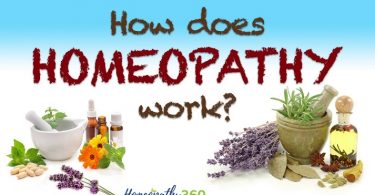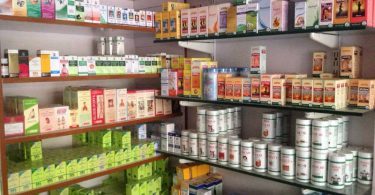
Abstract
Allergic rhinitis is a common and often debilitating disease, marked by rhinorrhoea, nasal congestion, nasal itching and sneezing, which is on the increase worldwide.
Allergic rhinitis is a most common and often debilitating disease, which is marked by rhinorrhoea, nasal congestion, nasal itching and sneezing. This case report highlights the management of allergic rhinitis in a 36-year old female patient with homoeopathic treatment. The patient reported 4 year long history of repeated episodes of frequent sneezing, watery nasal discharge and raised IGE levels. The totality was formed on day 1 after thorough case taking and homoeopathic medicine Arsenic album was prescribed. The patient has been following up regularly for 9 months, over the period of time the frequency and intensity has been reduced and no episodes of allergic rhinitis had occurred since 5 months.
Keywords
allergic rhinitis, homoeopathic treatment, Arsenicum album
Abbreviations: Ig – immunoglobulin, TDS – thrice a day
Introduction
It consists of episodes of nasal obstruction, watery nasal drainage and sneezing. It can be seasonal and arises due to an instant supersensitivity reaction in the mucous membrane of respiratory tract. However, this is a global problem, which may be aggravated during harvesting period. Recurrent allergic rhinitis may be a precise reaction to antigens acquired from house dust, fungal spores or animal dander, but equivalent symptoms can be produced by physical or chemical stimulants – for example, pungent odours or fumes, including strong perfume and cold air.[1]
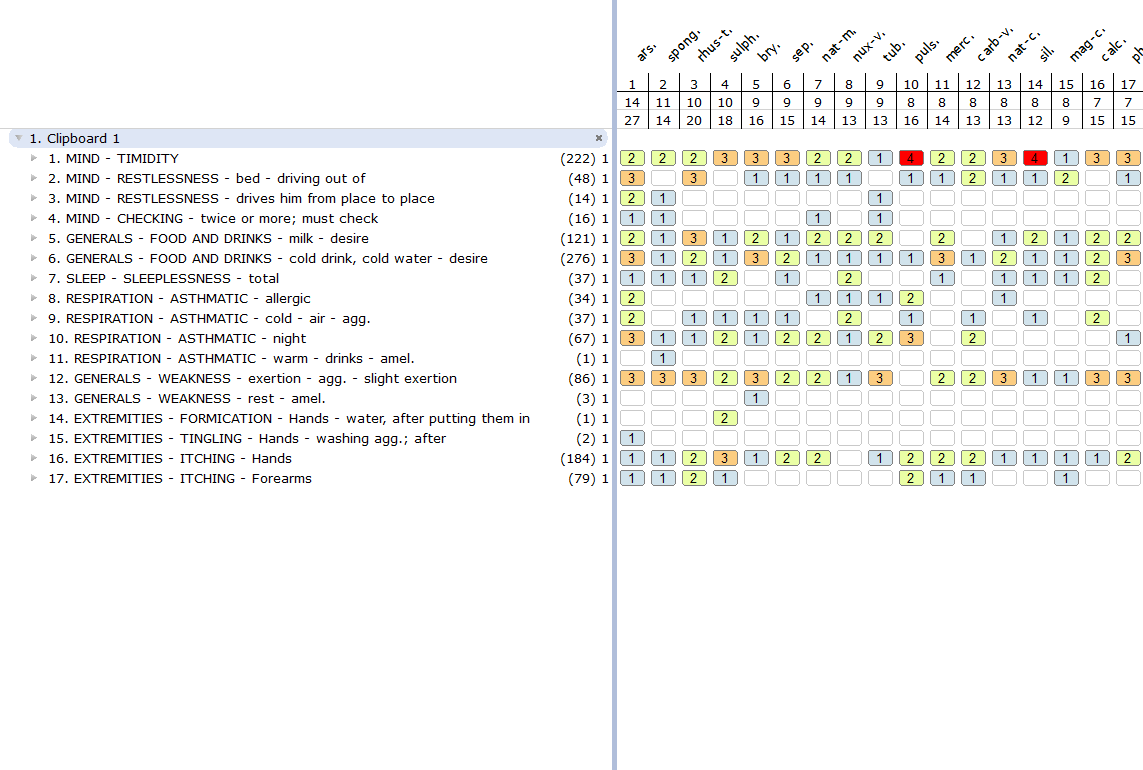
Classification
According to aetiology, it is classified as IgE mediated (allergic), autonomic, infectious and idiopathic. Also, according to symptom duration, it is classified as intermittent or persistent and on the basis of severity as mild, moderate or severe. It is considered intermittent when the total duration of the incident of inflammation is less than 6 weeks, and persistent when symptoms continue round the year and accomplish their day-to-day activities. Symptoms are categorized as moderate/severe if they significantly affect sleep and activities of daily living and/or if they are considered annoying. [2]
Pathogenesis
Allergens entering the respiratory tract, produce increased sensitivity of the mucous membrane of the nasal cavity and paranasal sinuses. When the very same allergen invades again an inflammatory IgE dependent reaction forms with infiltration of the nasopharyngeal mucosa. The resulting swelling of the mucous membrane makes it hard for the sinuses to spread within the nasal cavity and allergic rhino-sinusopathy develops, which rapidly turns into a chronic form. Therefore, increased reactivity begins to develop not only on arriving allergens, but also when any troublesome substance invades the mucous membrane of the nasopharynx.[3]
Symptoms
Symptoms arising shortly after coming into contact with the allergic substance may include: Prickling in nose, mouth, eyes, throat, skin, or any region, complications with smell, runny nose, frequent sneezing, watery eyes. Symptoms that may arise later include: nasal congestion, coughing and hyposmia, sore throat, puffiness under the eyes, lethargy and headache.[4]
Differential diagnosis
• Upper respiratory viral infections
• Chronic sinusitis
• Vasomotor or non allergic rhinitis.[5]
Complications
Acute or chronic sinusitis, otitis media, disturbance of sleep or apnoea, dental problems (overbite): stimulated by extreme breathing through the mouth, palatal deformities, eustachian tube dysfunction.[6]
Case report
A case of 36-year old, married, Hindu female who presented in Swasthya Kalyan Homoeopathic College & Research Centre OPD on 08/07/2021 for sneezing accompanied with runny nose since 3 to 4 days. She was suffering from these complaints from past4 years which aggravates every winter and on change of weather. On further inquiry, it highlighted that she had sore throat on speaking loudly, sneezing which aggravates from dust and spices. Runny nose and watery nasal discharge aggravated by cold wind, open air and house dust. Dry cough with scrappy sensation in throat and tickling was constantly present on exposure of dust. The patient had history of pain in bilateral knee joints12 years ago for which she took allopathic treatment and got relieved. The patient was dusky in complexion and of jolly nature. The mental generals reflected desire for company, anger after being dominated by her family members, desire for travelling, aggravation from consolation and fear of darkness. She was thirsty for small quantity of water at small intervals of time. She had desire of sweets, fruit juice, ice cream and milk, thermally chilly and had profuse perspiration on thigh. She was also suffering from leucorrhoea which was acrid, burning in nature and watery for 1 year.
Totality of symptoms:
- Dominated by family members
- Desire of company
- Fear of darkness
- Consolation aggravation
- Frequent sneezing
- Watery nasal discharge
- Tickling throat
- Thirsty, small quantity of small intervals
- Profuse perspiration on thigh
Analysis and evaluation of the case
| S.No. | Symptom type | Symptoms | Intensity |
| 1. | Mental general | Dominated by family members | ++ |
| 2. | Mental general | Desire of company | ++ |
| 3. | Mental general | Fear of darkness | ++ |
| 4. | Mental general | Consolation aggravation | + |
| 5. | Physical general | Thirst for small quantities of water in small intervals of time | ++ |
| 6. | Physical general | Desire of sweets | + |
| 7. | Particular symptom | Sore throat | + |
| 8. | Common symptom | Constant sneezing | ++ |
| 9. | Common symptom | Watery nasal discharge | +++ |
| 10. | Particular symptom | Ticking in throat | ++ |
| 11. | Particular symptom | Profuse perspiration on thigh | ++ |
Reportorial analysis:
Arsenicum album -18/7
Belladonna – 10/7
Aconitum napellus – 8/6
Investigations
The IgE levels pre-treatment were > 250 IU/mL and post treatment were > 124 IU/mL. IgE is the major antibody responsible for Type 1 hypersensitivity reactions and also for immediate allergic reactions.[7]
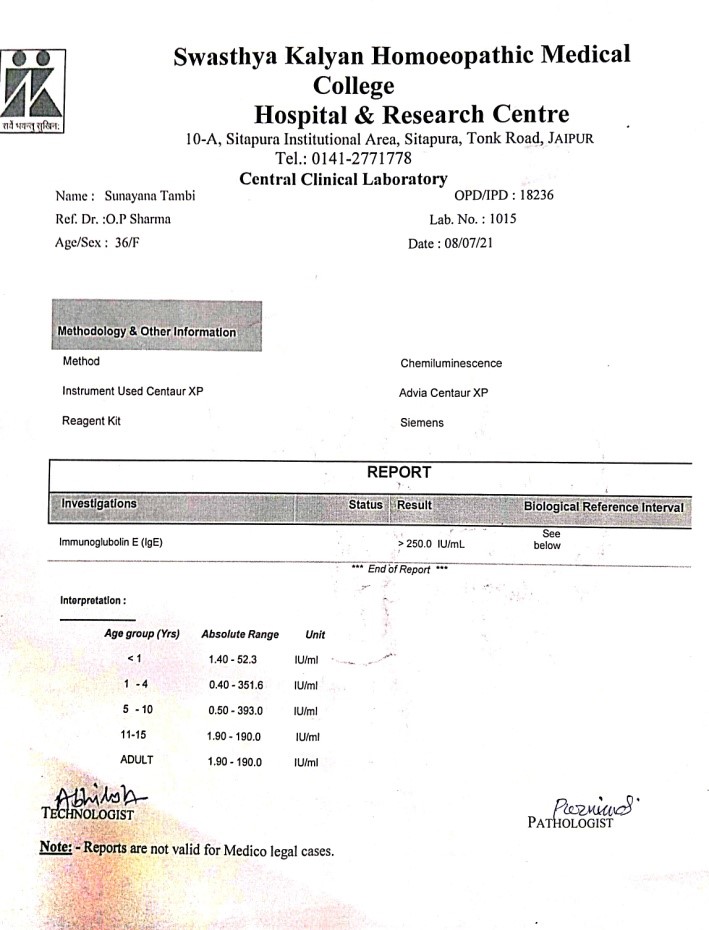
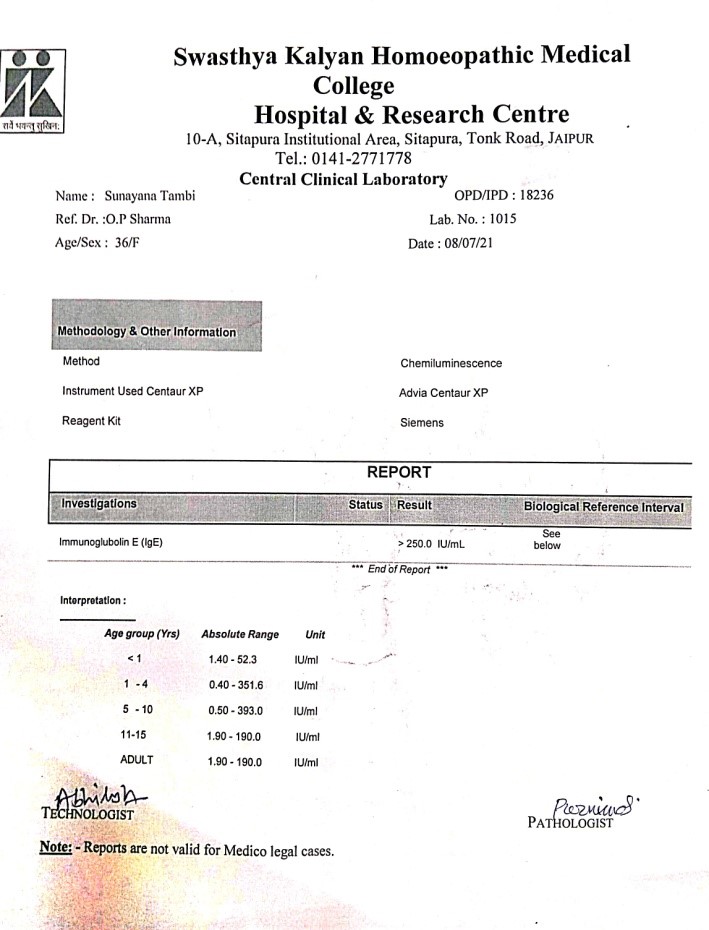
Justification
After analysing the symptoms of the case mental, physical and particular symptoms were considered for the make totality. Repertorial analysis using Murphy’s repertory (english) (mue110) RADAR 10[8] software was done considering the above symptomatology. Arsenicum album[9] not only covers the maximum rubrics but also covered the mental generals and periodicity of her disease in every winter and when weather was changed. After going through the clinical material medica of E.A. Farrington Arsenicum album was selected. Miasmatically, patient was psora-sycotic.[10] Potency selection was done after analysing the case and susceptibility of patient. The condition has become chronic and is not converted into syphilis till now. The patient’s susceptibility is appropriate for 200 potency as a dynamical dose is required to act in psora-sycotic condition. The medicine was repeated due to the appearance of same symptoms which were presented in the beginning.[10] The potency was kept 200 throughout the treatment as the patient was getting relief from the same potency.
Prescription
| Date | Prescription |
| 08/07/2021 | Rx Arsenicum album 200/ 1 dose stat Rubrum 30 TDS x 15 days |
Follow up
| Date | Symptoms | Prescription |
| 23/07/2021 | Relief in sneezing, relief in runny nose, slight relief in sore throat, slight relief in leucorrhoea. Dry cough was present. | Rx Rubrum 30 TDS x 16days |
| 20/08/2021 | Relief in cough, relief in sore throat, relief in leucorrhoea, no new complaints | Rx Rubrum 30 TDS x16 days |
| 14/09/2021 | Sneezing with dry cough, relief in leucorrhoea. Sore throat since 2 days | Rx Arsenicum album 200/ 1dose stat Rubrum 30 TDS x 16 days |
| 05/10/2021 | Slight relief in sneezing Relief in sore throat No new complaints. | Rx Rubrum 30 TDS x 30days |
| 02/11/2021 | Relief in sneezing and cough No new symptoms present | Rx Rubrum 30 TDS x 30 days |
| 11/12/2021 | No new symptoms | Rx Rubrum 30 TDS x 30 days |
| 25/01/2022 | No new symptoms | Rx Rubrum 30 TDS x 30 days |
| 26/02/2022 | Sneezing for 1 week Aggravation from dust | Rx Arsenicum album 200/ 1dose stat Rubrum 30 TDS x 16 days |
| 10/03/2022 | Relief in sneezing No new symptoms | Rx Rubrum 30 TDS x 15 days |
Conclusion:
Allergic rhinitis is one of the most prevalent disease conditions in young and middle age group, and is responsible for a significant impairment in quality of life. It can lead to complications such as asthma, sinusitis, nasal polyp if ignored. Homoeopathic medicines play an important role in managing allergic rhinitis and can help the patient to restore a healthy life. There is a superior scope in homoeopathy for its treatment as it is based on holistic and individualistic approach.
References:
1.Penman ID, Ralston SH, Strachan MWJ, Hobson R, editors. Davidson’s principles and practice of medicine. 24th ed. London, England: Elsevier Health Sciences; 2022.
2.2p FS, Becker A, Boisvert P, Bouchard J, Carr S, Cockcroft D, et al. The Canadian RhinitisWorking Group: Rhinitis: A practical and comprehensive approach to assessment and therapy. J Otolaryngol. 2007;36:S5–27.
3.Mymedical journal. Allergic rhinitis [Internet]. Medic Journal. 2021
[cited 2022 Apr 15]. Available from: https://medic-journal.com/allergic-diseases/allergic-rhinitis
4.Allergic rhinitis [Internet]. Medlineplus.gov. [cited 2022 Apr 15]. Available from: https://medlineplus.gov/ency/article/000813.htm
5.Tierney LM, Chief of Medicine Sanjay Saint, Whooley MA. Current essentials of medicine, fourth edition. 4th ed. McGraw-Hill Education/Medical; 2010.
6.Allergic rhinitis [Internet]. Medscape.com. 2022
[cited 2022 Apr 15]. Available from: https://emedicine.medscape.com/article/134825-overview
7.Kumar, V., Abbas, A. K., & Aster, J. C. Robbins and Cotran pathologic basis of disease (Ninth edition.). (2015).
8. Murphy’s repertory ,RADAR 10.0 English
9. Farrington EA. Farrington’s lectures on clinical material medica. 4th ed. New Delhi : B. Jain Publishers; 2004.
10.Dhawale ML. Principles and Practice of Homoeopathy. Vol. 1. Bombay : Institute of Clinical Research; 2000. 448 p.
About Author:
Prof. Dr Yogeshwari Gupta1, Dr Stuti Rastogi2, Dr Preeti Srivastav3
1Principal, Head Of Department, Department of Homoeopathic Materia Medica , Swasthya Kalyan Homoeopathic Medical College & Research Centre, Sitapura, Jaipur, Rajasthan, India
2M.D.(PGR), Department of Homoeopathic Materia Medica, Swasthya Kalyan Homoeopathic Medical College & Research Centre, Sitapura, Jaipur, Rajasthan, India
3M.D. (PGR), Department of Practice of Medicine, Swasthya Kalyan Homoeopathic Medical College & Research Centre, Sitapura, Jaipur, Rajasthan, India




